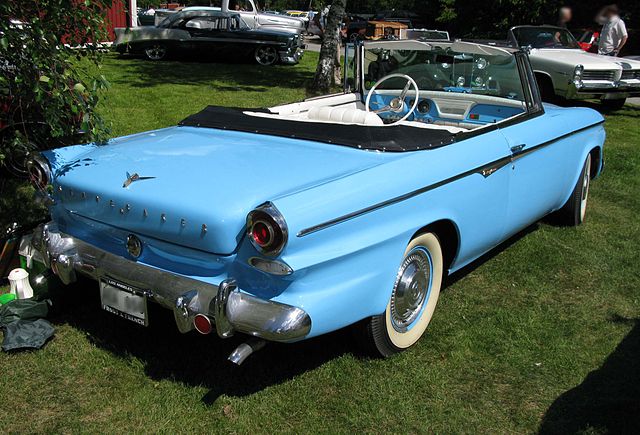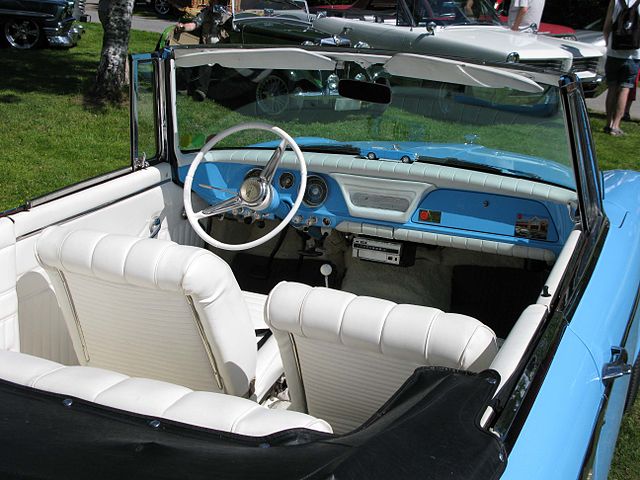Part 1 - The First Generation Lark Studebaker was one of the earliest automobile manufacturers. They were founded in 1852 and initially produced wagons for the military, farmers and other industries. In 1904 they began manufacturing their first gasoline vehicles under the brand name of "Studebaker Auto Company". Over the…
The Studebaker Lark – Second and Third Generations
Welcome to part two of our spotlight on the Studebaker Lark, part of our series on affordable classic cars. In this article we’re going to discuss the second and third generation Lark, which were made between 1962-1966.
Second Generation (1962 – 1963)
Studebaker was beginning to face competition from more and more auto manufacturers. They no longer had control over their niche, as practically every automaker had begun making cars to compete with the Lark.
In an attempt to combat a dwindling market share, Studebaker-Packard hired famous industrial designerBrook Stevensto create an update that would be both significant and cost-effective. The body was elongated, and Stevens used his interior design experience to update the inside. The story goes that Studebaker executives were absolutely thrilled with the updates, especially considering the limited budget he had to work with.
Bucket seats were becoming very popular and Studebaker hopped on the bandwagon with the brand new model called the Daytona. The Daytona replaced the Regal and became the high-end trim option for both convertibles and hard tops.
In 1962 every four- door Lark switched to OEM Wheels similar to the Cruisers 113 wheelbase of the past.Although the Cruiser was still the only four-door option available with vent windows in the rear. Two-door Cruisers wheelbase increased ever so slightly, just half an inch larger to 109 inches.
The two-door Deluxe series wagon had been losing popularity, which led Studebaker executives to discontinue the model in 1962. However, Studebaker had some leftover 1961 two-door wagon bodies and used 1962 front ends to fulfill a government order. No one knows exactly how many of these were produced, and there are no known surviving examples. If you were to find one, you would be looking at one extremely rare car.
Brook Stevens’ redesign immediately improved the dwindling sales that Studebaker had been experiencing. Studebaker sold over 90,000 Larks in 1962, despite a strike at their manufacturing plant that halted production for 38 days. If not for the strike, experts speculate that they would have sold over 100,000.
In 1963, Stevens again redesigned the Lark. The new design featured an updated windshield and other aesthetic improvements. Also, the Daytona line was expanded, and a new Custom trim level was offered.
Halfway through ’63, the Standard series was introduced, a totally bare bones Lark model, although it did not bear the Lark name. This model was geared towards the frugal-minded, had no side trim and a plain interior. The vehicle was perfect for fleets, and offered great value for just under $2K new. To put that number into perspective, after adjusting for inflation that would be about $15,000 today.
Unfortunately, the 1963 model did not impress consumers, who saw the new styling as a minimal update, and sales fell to below 80,000.
Third Generation (1964-1966)
Studebaker still had faith in Stevens, and allowed him to design restyling that would modernize their fleet while at the same time staying within their small budget. When you really think about the limited capital he had, what Stevens pulled off with Studebaker over the years was amazing. The resulting 1964 Lark resembled a Mercedes with an aluminum grille and square shaped headlight enclosures. Stevens was a mater at creating new designs that were inexpensive and also utilized Studebaker’s existing tooling.
The plan was to abandon the “Lark” name completely with the third generation. Studebaker named the basic model the Challenger, and brought back the Commander namesake (which was a full sized Studebaker as recently as 1958) and continued with the Daytona and Cruiser.
Commanders and Challengers will still referred to as Larks, but apart from a solitary Lark emblem on the sail panels, no identification on the car would indicate that they were in fact a Lark. Studebaker believed the public had grown tired of the name and has begun associating negative opinions with it.
Let’s back up a bit to 1963. Dwindling sales had created turmoil among the board of directors at Studebaker. Eventually, Studebaker decided it was time to get out of the auto industry, much against the company’s President Sherwood Egbert’s wishes.
Egbert was battling cancer, and the board of directors used this against him to force him out of the decision making process. Studebaker began liquidating assets and shutting down factories, but to avoid any litigation, which they could not afford, they had to do so slowly to avoid breaking contracts with dealers and suppliers. The South Bend plant, responsible for the production of Studebaker automobiles, closed down in December of 1963. Studebaker continued to manufacture Larks in Canada until 1966, making minor changes to the models each year, but ultimately 1966 saw the demise of the Lark. The last Studebaker Lark rolled off the Canadian assembly line in March of 1966. The Studebaker company went out of business shortly after in 1967.
If you decide to pick up a Studebaker Lark, you will be buying a classic car with a lot of cool history and, depending on what year and engine you choose, some substantial power under the hood. Remember, we have a great selection of vintage hubcaps and access to even more wheels, hubcaps – whatever you need. If we don’t have what you’re looking for odds are we know where to find it.









